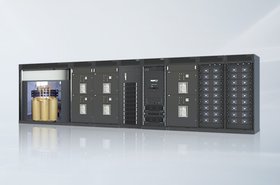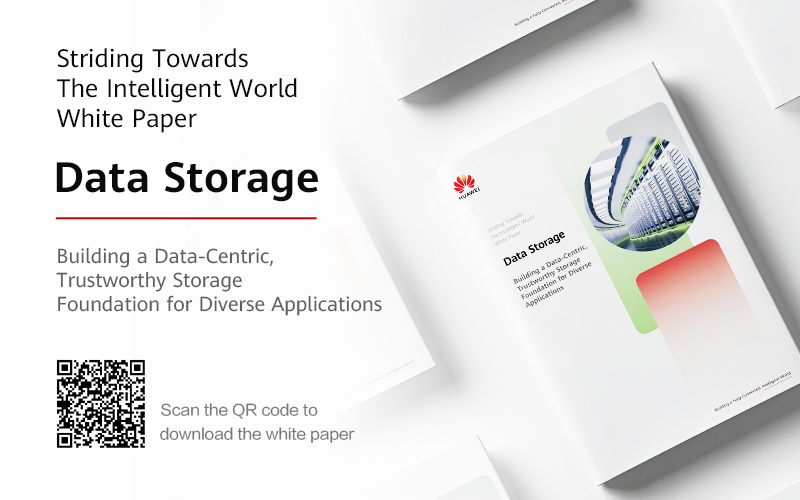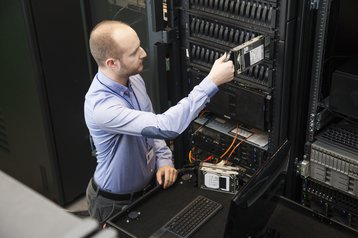When was the last time your company revisited its data storage needs? If you’re still just dumping everything into a cold room in the basement, you’re probably not making the most of the opportunities to secure systems, leverage data and centralize offerings.
The truth is, how you store and share information should be at the heart of your entire IT stack, and thanks to the flexibility and elasticity of current offerings – backed up with 5G, AI and cloud – even the smallest business can benefit from an infrastructure on par with a multinational.
Huawei’s latest white paper, ‘Striding Towards The Intelligent World: Data Storage’, explores in detail the wide range of options available to the modern business, the reasons why storage should be at the beating heart of any ambitious organization’s tech stack, and the challenges they may face in choosing the right solution for you.
The unstructured data explosion
Every second of every day, unstructured data points are being generated by the million and with the number of devices creating data exploding, this is accelerating. Unstructured data means ‘raw’ data, which sits on a drive verbatim and, until recently, was almost impossible to gather information from.
From fitness trackers to autonomous vehicles, huge swathes of unstructured information have to be stored. Most of those bytes will never be retrieved again, but every single one nevertheless has to be stored somewhere.
That means that companies need to start looking now at handling storage in terms of – not just petabytes – but exobytes or even yottabytes. It’s a brain-bending amount: one single exobyte could hold the entire contents of the US Library of Congress 100,000 times over.
Security threats are the problem. Data protection is the solution
It’s almost impossible to talk about technology these days without mentioning ransomware and many other computer security risks.
With ransomware, cyber criminals have proven that the business model of remotely locking files, demanding a ransom for their release and then, maybe, emailing the decryption key so that they can be retrieved has become an everyday hazard for businesses.
However, equally likely, the data will simply be stolen and exploited, and you’ll have paid the ransom for nothing.
Ignoring the risks, or assuming your data isn’t of interest to criminals simply doesn’t work any more. That makes your data management and security policies an intrinsic and essential part of your IT stack.
It also means that your business needs to combine the skills of your database managers and security managers to create a joined-up policy on all kinds of malware, including ransomware.
Becoming a victim of a security breach, of any kind, is about more than the effect on your data or your ability to pay any ransom.
Such attacks can lead to service disruption and the compromise of personal data entrusted to you. As a consequence, cyber attacks affecting data also need to be reported to both a data protection regulator, as well as an industry regulator.
The company’s reputation will almost be tarnished as a result – in some cases beyond repair, as proved to be the case with global foreign exchange company Travelex following a catastrophic ransomware incident in December 2019.
If they can, why can’t you?
Think about it for a second. We’ve talked about how valuable your data might be to criminals, so why do you leave your unstructured data sitting on a drive, when it could be working for you? Leveraging the information you’re collecting every second of every day can give you a competitive edge.
We’re now in an age where AI-based solutions can provide an affordable way to organize otherwise unstructured data and put it to work for the business, both in terms of creating a 360-degree business intelligence resource, and for customers by offering faster access to the data the organization hosts.
The days of simply having a rack of mechanical drives in the basement is long gone. The nature of modern business means that a single site data center is neither practical, nor desirable.
There are two ‘new normals’ to consider.
The first is the affordability of all-scenario flash arrays to replace conventional mechanical storage devices. These solid-state drives have crashed in price over the past decade to become the first choice for businesses starting out, or reviewing their storage needs. The benefits include longevity and durability, leading to reduced maintenance costs.
Then there’s speed of accessing records – great for you and your customers, increasing throughput and collating meaningful business trends. AI-controlled storage can also organise your storage to reduce duplication, move regularly accessed “hot” data to the fastest devices, and rarely (or never) accessed information on cheaper “cold” storage devices.
Your storage choices can save the world (at least a little)
Every organization needs to think about how it can reduce its environmental impact. It is estimated that by 2025, the proportion of the world’s energy consumption attributable to data centres will reach 4.5 percent – a quadrupling in just 15 years.
With a growing number of businesses looking at “net zero” and “carbon negative” models, storage has become a powerful tool to ensure you’re doing everything you can to keep your organization’s sustainability commitments.
There’s a number of ways to do this: centralized storage gives customers the flexibility to choose the exact amount of hardware they need, and waste none. Flash storage uses less energy than traditional mechanical drives, reducing energy costs and emissions, while offering vastly superior performance.
AI-optimization reduces overheads by ensuring that devices are used in the most optimal way, bringing together multiple clouds and fixed locations – across devices, racks, sites, and even oceans. It does this on-the-fly at a speed that no human could possibly achieve.
Under the theme “Unleash Digital”, Huawei Connect 2022 has travelled to Bangkok, Dubai and Paris. The last stop will be in Shenzhen on 7th November.
The annual event introduces a number of ICT products, portfolios, and solutions designed to meet the needs of various industry scenarios. Through a series of summits, broadcasts, and exhibitions, we also give a sneak peek at new groundbreaking innovations, as well as best practices and results from our work with customers and partners around the world.
Download ‘Striding Towards The Intelligent World: Data Storage’ to learn more about the unstructured data explosion, how the price of flash-based storage has plunged over the past decade, lowering energy consumption, and how good data management can mitigate business-terminating security risks or watch the video here.
More...
-

Huawei plans for third Chile data center
Chinese firm continues LATAM expansion
-

Huawei updates PowerPod to save space and energy
PowerPod 3.0 has better architecture, takes less space, and is more efficient
-

In search of the world's largest data center
Finding out who owns the biggest data center on the planet is harder than you might think





